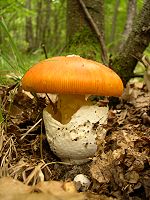Amanita caesarea
It was known to and valued by the Ancient Romans, who called it Boletus, a name now applied to a very different type of fungus.
Although it is edible, the Caesar's mushroom is closely related to the psychoactive fly agaric, and to the deadly poisonous death cap and destroying angels.
[5] The Romans called it Bōlētus, derived from the Ancient Greek βωλίτης for this fungus as named by Galen.
[6] Several modern common names recognise this heritage with the English Caesar's mushroom and royal amanita, French impériale, Polish cesarski and German Kaiserling.
The relationship of the similar North American species A. arkansana and A. jacksonii to A. caesarea is not clear.
A similar mushroom can also be found in La Esperanza, Honduras, where a festival is celebrated annually in its honor.
The surface is smooth, and margins striated, and it can reach 15 centimetres (6 inches) or rarely 20 cm (8 in) in diameter.
The base of the stipe is thicker than the top and is seated in a greyish-white cup-like volva, which is a remnant of universal veil.
[12] A study of the organic acid composition of mushrooms found a relatively high level, about 6 g/kg, in A. caesarea.
In warmer climates this mushroom fruits in higher oak woodlands, sometimes mixed with conifers.
Thus, in Mexico its natural habitat is oak, pine or fir forests at altitudes of 2,200–3,000 m (7,200–9,800 ft) above sea level, where it prefers plains and can occur at slopes of 20 degrees.
[21] A. caesarea is listed in the Red Data book of Ukraine,[22] and it is protected by law in Croatia,[23] Slovenia,[24] the Czech Republic[25] and Germany.

